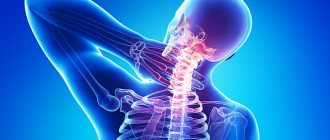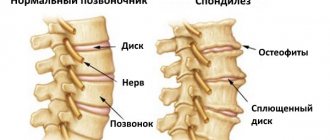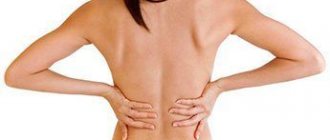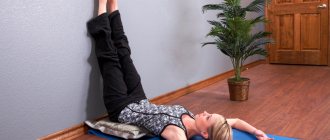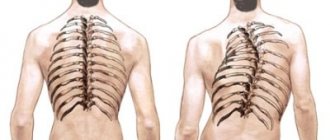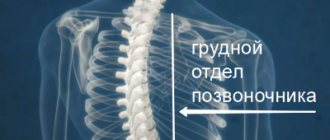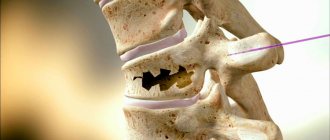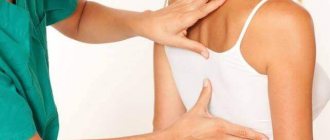- Home >
- Directory >
- Spine treatment >
- Kyphoscoliosis
Kyphoscoliosis is a pathological curvature of the spine that combines two diseases - scoliosis and increased kyphosis.
It manifests itself simultaneously as a curvature of the spine with a convexity backwards and sideways, as well as rotation of the vertebrae (turning relative to each other). Teenagers are the most susceptible to kyphoscoliosis; according to statistics, this type of pathology occurs four times more often in boys than in girls.
The presence of kyphoscoliosis in an adult indicates a gradual process of spinal deformation under the influence of scoliosis or kyphosis that was not cured in childhood.
Why does kyphoscoliosis develop?
Among the main reasons for the development of kyphoscoliosis are the following:
- Weak back muscles. If the child’s physical development is insufficient, the muscles are not able to adapt to the rapid growth of the spinal column, which may result in modification of the shape of the vertebral bodies and subsequent curvature of the spine.
- Passive lifestyle. Incorrect position at the desk at school, office and at home, combined with a lack of physical activity, leads to deterioration of posture and the onset of deformation processes.
- Social and psychological difficulties. The habit of slouching is a reflexive attempt by the body to “protect itself” from external influences. It often occurs under the influence of factors such as high growth, constant pressure from others, and emotional overload.
- Excessive physical activity. In adolescence, excessive strength exercises aimed at strengthening the pectoral muscles, without proper development of the ligamentous-muscular apparatus of the back, can lead to stooping and a syndrome such as “sunken chest”.
- Uneven loads on different parts of the body. Sports such as tennis and fencing promote the development of only one muscle group, ignoring others, which can result in curvature of the spine in one plane or another. Playing the cello, accordion, as well as differences in leg length can lead to the same results.
- Diseases suffered in childhood. These include rickets (vitamin D deficiency), polio, and tick-borne encephalitis. In addition, the consequences of radiation therapy can have a negative impact.
- Consequences of injury or surgery on the spine.
Symptoms
Congenital kyphoscoliosis reveals itself by six months or a year. The child develops a small hump. It has nothing to do with the muscle roll in scoliosis, since it consists of bony protrusions of the vertebrae. The curvature is noticeable when the child is sitting or standing and disappears when lying down. Over time, the bulge does not disappear completely. Almost half of the cases of congenital kyphoscoliosis are accompanied by neurological disorders, paresis and loss of sensitivity at a young age.
In adolescence, kyphoscoliosis affects posture. The teenager begins to slouch and complain of back pain and shortness of breath. Neurological disorders in this case are rare and more common in severe forms of the disease.
Externally, kyphoscoliosis can be determined by:
- round back (severe stoop);
- tilting the upper body forward and downward;
- narrow chest;
- weak abdominal muscles;
- increased distance between the ribs on the side opposite to the curvature.
Complications of kyphoscoliosis overload both the spine and the surrounding muscles. In severe forms, the diaphragm becomes inactive, lung volume decreases, heart function deteriorates, and the functioning of the digestive tract is disrupted. As a result, a very young person receives a bunch of diseases and the threat of disability.
Classification of kyphoscoliosis
Kyphoscoliosis is classified based on the reasons that caused it:
Congenital kyphoscoliosis is caused by anomalies in the development of individual vertebrae (for example, the acquisition of a wedge-shaped or underdeveloped shape), as well as the formation of extra or fused ribs. As a rule, signs of congenital kyphoscoliosis can be noticed in the sixth month of a child’s life. It responds well to treatment in the early stages of development.
Hereditary kyphoscoliosis manifests itself in a similar form in several generations and is transmitted in a dominant manner. Associated with genetic diseases such as Scheuermann-Mau disease.
The prerequisites for acquired kyphoscoliosis may be poor posture, osteochondrosis, spinal tumors, and some diseases of the muscular system and musculoskeletal system.
In other cases, it is not possible to establish the cause of kyphoscoliotic disease. This type of kyphoscoliosis is called idiopathic . Most often, this type of disease occurs in adolescents aged 11-15 years.
If you have any questions, ask our specialist! Ask a Question
General information
The name kyphoscoliosis comes from two Greek words that translate as “hunchbacked, bent” and “crooked”. This disease is diagnosed if the patient has a pathological curvature of the spine in the frontal and sagittal planes. That is, the spine is curved in both the lateral and anteroposterior directions at the same time. Kyphoscoliosis, whose ICD-10 code is M41, manifests itself with signs of both scoliosis and kyphosis .
Kyphosis in the thoracic region is combined with curvature of the spine to the left or right side. This condition can be either congenital or acquired. According to medical statistics, kyphoscoliotic posture is observed in approximately 1% of people in the world. Of all these people, 90% of the cases do not require treatment. And only 10% of patients develop a severe form of the disease that requires treatment, since this pathology can lead to complications over time. What is kyphoscoliotic posture, why is it dangerous, and how to correct the situation will be discussed in this article.
Consequences that kyphoscoliosis can lead to
The course of kyphoscoliosis negatively affects, first of all, the functioning of the respiratory system. When the shape of the chest changes, the volume of the lungs decreases, the load on the respiratory muscles increases, and the chest wall becomes stiff. Pulmonary hypertension is likely to develop during exercise, and sometimes at rest. With severe degrees of kyphoscoliosis, gas exchange is disrupted.
In addition, damage to the cardiac and genitourinary systems is possible, including heart failure, cor pulmonale and incontinence. Advanced kyphoscoliosis can lead to disability.
Please note that with kyphoscoliosis, physical exercise is allowed only according to the recommendations of the attending physician. Self-medication and excessive exercise can lead to a significant deterioration of the condition.
Causes
Kyphoscoliosis most often develops against the background of an abnormal development of the spine.
The development of this disease is facilitated by the following diseases and conditions:
- genetic deficiency of connective tissue;
- rickets;
- spinal tumors;
- osteochondropathy;
- Scheuermann-Mau disease;
- myopathy;
- paralysis;
- muscular dystrophy associated with cerebral palsy or polio ;
- impaired muscle tone in a newborn;
- discrepancy in the rate of development of bone and muscle tissue during the period when a person is actively developing and growing.
There are also some factors that contribute to the development of the disease:
- strong physical stress on the spine;
- excess weight;
- passive lifestyle;
- injuries and operations.
Diagnosis of kyphoscoliosis at the MART clinic
If you suspect spinal curvature, you should contact an orthopedic traumatologist. A diagnosis of kyphoscoliosis may also require a visit to a neurologist.
Our specialists will assess the degree and nature of spinal deformity and possible progression of the disease; The muscle strength, tendon reflexes, and skin sensitivity will be checked.
For subsequent treatment, it is important to recognize the primary arc of spinal curvature, which is different from the compensatory countercurvature, since it is this that is susceptible to the progression of deformation processes. The compensatory curvature disappears when the primary one is eliminated.
To make an accurate diagnosis, a comprehensive examination using a magnetic resonance imaging scanner is necessary.
If there are symptoms of cardiac and respiratory system dysfunction, additional diagnostics may be required. The projections clearly show the sideways curvature of the spinal column (scoliosis) on the left and the convexity backwards (increased kyphosis) on the right. At the MART medical center you have modern equipment from leading foreign manufacturers, including an expert-class tomograph.
Forecast
The prognosis depends on the degree of the disease and the rate of its progression. As a rule, with the help of adequate treatment for kyphoscoliosis of the first and second degrees, it is possible to completely eliminate the pathology of the spine. But for this, it is important to carry out treatment before the end of the period of active growth, that is, until approximately 15 years.
With third and fourth degree kyphoscoliosis, it is almost impossible to completely cure the disease. But with proper treatment, it is possible to stop the deformation and partially correct the curvature.
If left untreated, severe idiopathic kyphoscoliosis causes the person to die by age 50 due to pulmonary hypertension and respiratory failure.
Degrees of kyphoscoliosis
Depending on the severity of deformation changes, kyphoscoliosis is divided into four degrees:
- Kyphoscoliosis 1st degree - deviations in the bending and twisting of the spine are minimal
- Kyphoscoliosis 2nd degree - progression of the disease, characterized by a more pronounced lateral deviation of the spine, twisting
- Kyphoscoliosis 3rd degree - the beginning of irreversible deformation processes, changes in the shape of the chest, formation of a rib hump
- Kyphoscoliosis 4 degrees - the deformation affects the spinal column, hip joint and chest. An anterior and posterior hump appears.
At the MART clinic on Vasilyevsky Island
- Experienced doctors (including those practicing in the USA and Europe)
- Prices affordable for everyone
- Expert level diagnostics (MRI, ultrasound, tests)
- Daily 8:00 — 22:00
Make an appointment
Diagnostics
Before starting to develop a treatment plan for kyphoscoliosis, our doctors conduct a comprehensive diagnostic examination, which allows us to accurately make a diagnosis, identify the causes of the pathology and its consequences for the body. First of all, an examination is carried out by a specialist and anamnesis is taken, after which the following studies are prescribed:
- radiography;
- Magnetic resonance imaging;
- CT scan;
- lab tests.
If neurological disorders are identified during the diagnostic process, a consultation with a neurologist is scheduled. If there are symptoms indicating a dysfunction of internal organs, additional diagnostics and consultations are carried out with a urologist, cardiologist, gastroenterologist and pulmonologist.
Treatment of kyphoscoliosis
Initial degrees of kyphoscoliosis can be successfully treated with conservative treatment. More severe deformities may require surgery.
In our clinic you have the opportunity to undergo conservative treatment of kyphoscoliosis, as well as be examined by a surgeon if surgery is necessary.
Methods of conservative treatment of kyphoscoliosis at the MART clinic
| Developing habits for correct posture | Recommendations on how to “keep your back” while sitting, standing, when walking, and also how to arrange your sleeping place |
| Physiotherapy | This treatment method is indispensable for any curvature of the spine. Includes the development of a course of exercises for self-study and exercise therapy sessions with an individual instructor |
| Physiotherapeutic treatment | It has a wide range of capabilities for relieving pain, improving blood circulation, lymph circulation and eliminating muscle dystrophy. |
| Manual therapy | Helps improve posture and gait, partially or completely eliminate deformities of the vertebrae, intervertebral discs, joints and adjacent tissues |
| Massotherapy | Used as a supplement to the main course of treatment |
| Orthotics | Prescribing orthopedic corsets, reclinators and belts to develop correct posture and fix the shape of the spine |
| Drug treatment | Prescribing anti-inflammatory and painkillers to relieve pain |
Diet
Diet for osteochondrosis
- Efficacy: no data
- Timing: constantly
- Cost of food: 1450-1780 rubles per week
Dietary nutrition cannot save a person from kyphoscoliosis. But still, for comprehensive treatment it is important to eat right. It is important to include foods containing vitamins B, C, D, P, as well as magnesium and calcium into the diet. The basis of the menu should be cereals, dairy products, eggs, lean meat, fish, vegetables and fruits.
It is important to give up pickles and smoked meats, alcohol, fast food, unnatural foods, marinades, etc.
Prevention of kyphoscoliosis
In our medical center, you have the opportunity to consult on preventive measures to prevent the development of kyphoscoliosis and other diseases of the spine with specialists in the field of orthopedics, neurology, as well as with a physical therapy doctor - to draw up an individual training program to strengthen the musculoskeletal system and ligamentous muscular apparatus.
The article was reviewed by Doctor of Medical Sciences, Professor Grigory Isaakovich Shvartsman, Northwestern Medical University. I.I. Mechnikov.
Sign up at the MART medical center in St. Petersburg (see map) by phone, or leave a request on the website.
List of sources
- Nasonova, V.A. Diseases of the musculoskeletal system and connective tissue in Russia: dynamics of statistical indicators over 5 years (2005-2009) // Scientific and practical rheumatology. 2009. -N. 2. - P.4-12.
- Popelyansky Ya. Yu. Orthopedic neurology (Vertebroneurology): A guide for doctors / M.: MEDpress-inform, 2003. – 672 p.
- Shubkin M.V. Modern technologies for surgical treatment of deformities and diseases of the spine: materials of the third congress of spine surgeons of Russia with international participation. St. Petersburg, 2012. - pp. 195-196
